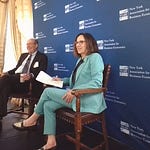In a world of geopolitical uncertainty, where inflation has come down from its punishing pandemic peaks, and where central banks around the world have pivoted now to rate cuts, commodity prices and where they are heading next is a major issue for policy makers.
Enter Ayhan Kose with the World Bank’s semi-annual “Commodities Markets Outlook,’ and one of the big messages when it comes to oil prices.
”Oil prices are under pressure. We are expecting, you know, on average this year, oil prices going to be around $80. Next year, $73 and 2026, around $72. That means, you know, you have the lowest oil prices since basically 2022.
”The a message is that in the context of oil markets simply there is a lot of oil out there and the amount of oil is basically larger than demand. Next year the expectation is that we will have an extra 1 .2 million barrels per day on average oil available So the supply is greater than demand.
”So when you look back, only two years in modern era, we had this type of surplus oil in 1998. You know, oil prices actually collapsed that year. And in 2020, when we had the COVID and oil prices collapsed, of course, during the year of COVID. So that's the supply story,” Ayhan says.
Looking ahead?
Ayhan sees going forward there is still a material risk of escalation of the conflict in the Middle East…which could push prices up sharply.” If the risks materialize and we see escalation and we see disruption of oil supply We think that the one scenario is we to lose, give and take 2 million barrels oil per day supply.”
In a special section of the report he looks at how the pandemic-driven ups and downs of the global commodity markets drove synchronized swings in inflation around the world, and then in turn drove central banks in the same down and up and down again paths in rate cuts down, rate hikes up, and then cuts down again.
”When you look at the global inflation over the past five years from 2020 to 2024 even starting in 2021, 2022 increases in energy prices, especially oil prices pushed headline inflation up. And then you come to 2023, you come to 2024, headline inflation is coming down, a big chunk of that driven by, of course, oil prices, the energy prices, and food prices.
“So the rest, the core, especially the services price inflation, still quite sticky, and it increasingly is the main driver of inflation. So the good news, if our oil price forecast is correct, the pressure associated with these oil prices, overall commodity prices on inflation will continue to disappear.
“That means inflation expectations, if they are driven by this headline changes in the inflation, are going to continue to moderate. And that will help central banks in terms of (how) they are going through this cycle…seeing that basic, inflation, are going to continue to moderate.”
So dive in and get a tase of this 50-plus page commodities outlook report. Ayan adds a lot of context, especially when it comes to global central banks, why and how they should be able to move again in step and continue to move toward their inflation targets — including in developing and emerging market economies.
Ayhan Kose is the Deputy Chief Economist of the World Bank Group and Director of the Prospects Group. He is a member of the Chief Economist’s leadership team overseeing the Bank’s analytical work, and policy and operational advice. He also leads the Bank’s work on the global macroeconomic outlook, financial flows, and commodity markets. Under his management, the Prospects Group produces the Bank’s flagship reports Global Economic Prospects and Commodity Markets Outlook, in addition to other policy and analytical publications. Prior to joining the World Bank, he was Assistant to the Director of the Research Department and Deputy Chief of the Multilateral Surveillance Division in the International Monetary Fund (IMF). He served in a wide range of roles supporting IMF’s analytical, policy, and operational work.
Mr. Kose has written extensively on international macroeconomics and finance. His articles have been published in leading academic journals, including the American Economic Review, International Economic Review, Journal of Monetary Economics, Journal of International Economics, Journal of Development Economics, and many others. His latest book, Falling Long-Term Growth Prospects (co-edited), examines the evolution of global potential growth and its underlying drivers. His recent policy work focuses on global inflation, debt challenges, and business cycles.
Mr. Kose is a Nonresident Senior Fellow at the Brookings Institution, a Dean’s Fellow at the University of Virginia’s Darden School of Business, a Research Fellow at the Center for Economic Policy Research (CEPR), and a Research Associate at the Center for Applied Macroeconomics (CAMA). He taught at the University of Chicago’s Booth School of Business, INSEAD, and Brandeis International Business School. He has a Ph.D. in economics from the Tippie College of Business at the University of Iowa and a B.S. in industrial engineering from Bilkent University. A native of Turkey, Mr. Kose was born and raised in Istanbul.













Share this post